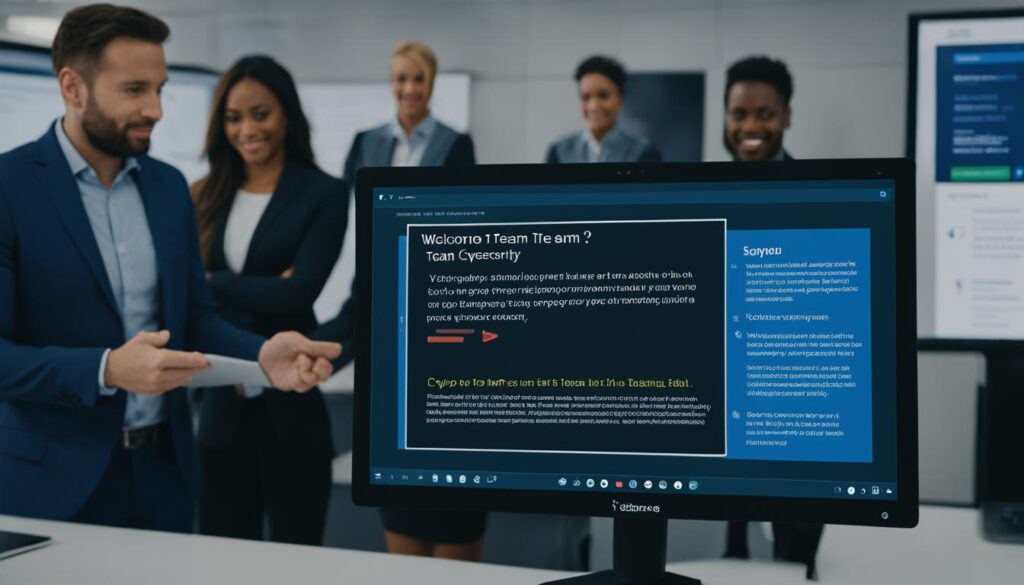Welcome to our guide on how to optimize user onboarding and improve the onboarding process for your organization. Effective onboarding is essential for setting your new employees up for success and ensuring the overall health of your company. Unfortunately, many organizations struggle with onboarding, leading to high turnover rates and decreased productivity. In this article, we will provide you with valuable insights and strategies to optimize your onboarding process and enhance the new hire experience.
Key Takeaways
- Clear goals and objectives are crucial for an efficient onboarding process.
- Engage with new hires before their first day to create a personalized onboarding experience.
- Assigning mentors or buddies can provide valuable support to new hires.
- Make a positive first impression and establish an orientation plan for new hires.
- Continuously gather feedback and make improvements to enhance future onboarding efforts.
Setting Clear Onboarding Goals and Objectives
Optimizing your onboarding process begins with setting clear goals and objectives. By doing so, you can ensure a smooth and successful transition for new hires. Here are some key steps to consider:
1. Structure your onboarding program
Start by organizing the content of your onboarding program. Determine the essential information and skills that new hires need to acquire. This might include company policies and procedures, job-specific training, or cultural values. By structuring your program, you provide a framework that helps new hires navigate their transition more effectively.
2. Establish projected timetables
Outline a timeline for the onboarding process, dividing it into relevant stages. This can range from the initial orientation to gradually immersing new hires into their roles and responsibilities. Having projected timetables ensures that the onboarding process is completed within a reasonable timeframe, avoiding unnecessary delays and confusion.
3. Identify key stakeholders
Determine the individuals or teams that will be involved in the onboarding process. This includes HR personnel, managers, and colleagues who will play a role in the successful integration of new hires. Assigning specific responsibilities to each stakeholder ensures that the onboarding process is well-coordinated and that new hires have the necessary support from day one.
4. Tailor the onboarding process
Recognize that each role within your organization may require different onboarding approaches. Tailoring the process to meet the unique needs and challenges of each position helps new hires feel valued and prepares them for success. Consider the specific goals and objectives for each role and customize the onboarding experience accordingly.
5. Solicit feedback from employees
To continually improve your onboarding process, gather feedback from new hires and employees who have recently undergone onboarding. This feedback can provide valuable insights into areas where enhancements can be made. Encourage open and honest communication to ensure that the onboarding process meets the evolving needs of your organization and its employees.

Setting clear goals and objectives is a critical step in optimizing your onboarding process. By structuring the content, establishing timetables, involving key stakeholders, tailoring the process, and seeking feedback, you can create a successful onboarding experience that sets new hires up for long-term success.
Emphasizing Pre-Onboarding Efforts
Engaging with new hires before their first day is crucial for a successful onboarding experience. By focusing on pre-onboarding efforts, you can set the stage for a smooth transition and personalized onboarding experience.
One effective pre-onboarding practice is sending welcome packets to new hires. These packages can include information about the company’s culture, values, and important resources. By providing this information ahead of time, you can help new hires feel more prepared and excited for their first day.
An increasingly popular approach to pre-onboarding is virtual onboarding. This involves setting up virtual “meet and greets” with leadership and team members. Through video calls or virtual platforms, new hires can get to know their colleagues, ask questions, and start building relationships before stepping foot in the office. This virtual interaction helps foster a sense of belonging and connection from the very beginning.
Another valuable pre-onboarding practice is providing a comprehensive checklist. This checklist serves as a roadmap for both the new hire and the HR team, ensuring that all necessary paperwork, trainings, and introductions are completed in a timely manner. By streamlining the pre-onboarding process, you can provide a sense of structure and clarity to new hires, setting the stage for a smooth transition.
To optimize the pre-onboarding process, technology can be leveraged. Online platforms for paperwork and document management can streamline administrative tasks, reducing the time and effort required for manual processes. This allows new hires to focus on building relationships and getting up to speed with the company’s culture and values.
By emphasizing pre-onboarding efforts, such as welcome packets, virtual meet and greets, checklists, and technology optimization, you can ensure that new hires feel valued, supported, and prepared for their first day. This personalized onboarding approach sets the stage for a positive and productive journey with your organization.

Providing Support and Mentoring
When it comes to onboarding new hires, providing support and mentoring is crucial for their success and overall satisfaction. Assigning a mentor or buddy to new employees can have a significant impact on their well-being and productivity.
Having a designated mentor allows new hires to have someone they can turn to for guidance and support. This mentor can help answer questions, provide valuable insights, and offer advice based on their own experiences within the organization.
Mentorship programs not only provide practical support but also help foster a sense of connection and belonging. New employees can feel more confident and valued when they have someone they can rely on during their early days at the company.
In addition to mentorship, making a positive first impression is essential for setting the stage for a successful onboarding experience. Ensuring that the hiring manager is fully prepared and accessible for the new hire’s arrival can make a significant difference in their initial perception of the organization.
Setting up a 30-60-90 day orientation plan is another effective way to provide structure and support throughout the onboarding process. This plan helps new hires understand their role, responsibilities, and expectations in a gradual and manageable way, giving them the tools they need to succeed.
Conclusion
Optimizing your onboarding process is crucial for improving new hire retention, productivity, and engagement. By aligning your onboarding goals with your organizational strategy, leveraging technology, familiarizing new hires with your product or service, emphasizing corporate culture, and allowing for feedback and development, you can create an exceptional and memorable onboarding experience.
One way to measure the success of your onboarding process is by tracking relevant metrics and using onboarding analytics. These metrics can include time-to-productivity, employee satisfaction, and retention rates. By analyzing these metrics, you can identify areas for improvement and make data-driven decisions to enhance your onboarding process.
Additionally, implementing effective onboarding engagement techniques can further enhance the new hire experience. This can include interactive training programs, peer-to-peer learning opportunities, and ongoing communication channels. By providing continuous support and fostering a sense of belonging, you can ensure that new hires feel valued and are set up for long-term success within your organization.
Remember, onboarding is not a one-time event, but an ongoing process. Continuously gathering feedback from new hires and incorporating their suggestions will help you refine and improve your onboarding efforts. By investing in a comprehensive and well-structured onboarding process, you can create a positive and impactful first impression, leading to happier, more engaged, and productive employees.
FAQ
How can I optimize my onboarding process?
To optimize your onboarding process, it is important to outline clear goals and objectives. This involves structuring the content of your onboarding program, establishing projected timetables, and determining the key stakeholders who will be involved in the process. Tailoring the onboarding process to meet the needs of different roles and soliciting feedback from employees can also contribute to a successful transition for new hires.
What are some pre-onboarding efforts that can enhance the onboarding experience?
Engaging with new hires before their first day is crucial for a successful onboarding experience. This can be done through pre-onboarding efforts such as sending welcome packets, setting up virtual “meet and greets” with leadership and team members, and providing a checklist to consolidate the onboarding process. Leveraging technology to optimize the pre-onboarding process, such as using online platforms for paperwork and document management, can also enhance the experience for new hires.
How can providing support and mentoring contribute to a successful onboarding process?
Assigning a mentor or buddy to new hires can greatly contribute to their well-being and productivity. This provides them with much-needed support, a peer to reach out to with questions, and a sense of connection to the organization. Making a positive first impression on the first day, ensuring the hiring manager is fully prepared and accessible, and establishing a 30-60-90 day orientation plan can further enhance the onboarding experience and set new hires up for success.
What are some onboarding success metrics that can be used to evaluate the effectiveness of the process?
Onboarding success can be measured using metrics such as new hire retention rate, time-to-productivity, and engagement levels of new hires. Additionally, onboarding analytics can be leveraged to gather feedback from new hires and identify areas for improvement. By continuously gathering feedback and making adjustments to the onboarding process, organizations can ensure the success of future onboarding efforts.
What are some best practices for optimizing the onboarding process?
Some best practices for optimizing the onboarding process include aligning onboarding goals with the organizational strategy, leveraging technology to streamline the process, familiarizing new hires with the product or service, emphasizing corporate culture and values, and allowing for feedback and development. By implementing these strategies, organizations can create an exceptional and memorable onboarding experience for new employees.




